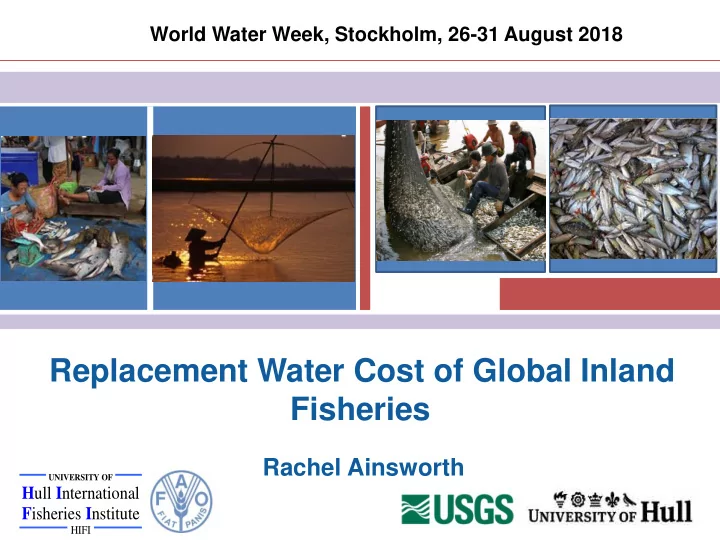

World Water Week, Stockholm, 26-31 August 2018 INSERT INSERT PHOTOS PHOTOS HERE HERE Replacement Water Cost of Global Inland Fisheries Rachel Ainsworth UNIVERSITY OF H ull I nternational F isheries I nstitute HIFI
Importance of Inland Fisheries Employment/ Economic Food/ Nutritional Cultural Empowerment Security • Increased • Improved • purchasing • Women involved Increased human power, in decision micronutrient health/ • Social safety net, making, intake, wellbeing, • • • Cash for income, • Full- time and Access to animal Community • Inland finfish part- time protein, identity, value USD 43 • • employment. Catch retained for Recreation. billion in 2015. household consumption. Inland fisheries
Dependence on Inland Fisheries • Orange outline indicates LIFDC
Invasive species Dams Inland fisheries are Climate change exposed to multiple Pollution pressures Fish exploitation Channelization Habitat loss Irrigation
Method Additional water demand (km 3 ), FAO 2015 Global Water footprint, land conversion and regional (km 2 ), and food land use and capture fisheries energy content of production to production (11.47 alternative foods replace kilojoules million tonnes) from fish (million tonnes)
Kilojoule replacement 20 Replacement of kilojoules of energy from FAO Global fish catch 18 protein from fish (million tonnes) 16 14 12 10 8 6 4 2 0 Farmed Farmed Farmed Beef Pork Chicken Rice Wheat Maize Common Salmon Tilapia Carp Replacement food • Aquaculture- 6 times global production, • Livestock- 8% of global production, • Crops- 2% of global production.
Water demand 120 Amount of water to replace kilojoules FAO Global fish catch 100 80 from fish (km 3 ) 60 40 20 0 Farmed Farmed Farmed Beef Pork Chicken Rice Wheat Maize Carp Salmon tilapia Replacement food • Beef- 4% of global agricultural water use,
Land use 1.4 Land required to replace kilojoules frmo fish FAO Global fish catch 1.2 1 (million km 2 ) 0.8 0.6 0.4 0.2 0 Farmed Farmed Beef Pork Chicken Rice Wheat Maize Carp tilapia Replacement food • Aquaculture- 24% of global inland water area, • Beef- 4% of global pasture land.
Pressure on water resources Where will additional water resources come from?
African Great Lakes (1.1 million tonnes) 12 Amount of water require to replace kilojoules from African Great Lakes FAO 10 Water demand 8 fish (km 3 ) 6 • Beef- 1.2 times regional 4 water use 2 0 Farmed tilapia Beef Pork Chicken Wheat Maize Replacement item 60000 Land required to replace kilojoules from African Great Lakes FAO 50000 Land use 40000 fish (km 2 ) • Aquaculture- 51% regional 30000 inland water area 20000 • Beef- 14% of regional pasture 10000 land 0 Farmed Beef Pork Chicken Maize Cassava tilapia Replacement item
South- East Asia (2.5 million tonnes) 25 Amount of water to replace kilojoules from fish South-East Asia FAO production 20 Water demand 15 (km 3 ) 10 5 • Beef- 7.6% regional water use, 0 Farmed Carp Farmed Farmed Beef Pork Chicken Rice tilapia Pangasius Replacement item 300000 Land required to repace kilojoules from fish South-East Asia FAO production Land use 250000 200000 • Beef- 1.4 times regional (km 2 ) 150000 pasture land area, 100000 • Aquaculture- 1.5- 3.1 times 50000 regional inland water area. 0 Farmed Carp Farmed Farmed Beef Pork Chicken Rice tilapia Pangasius Replacement item
Increased food imports Reduction in No access to nutrients capital Impact Dietary Livelihood of Inland change transition Fish loss Micronutrient No access to deficiencies land Agricultural expansion
Increased Food food prices insecurity Increased food imports Impact of Livelihood Dietary Inland transition change Fish loss Agricultural expansion Water quality Land- use decline change
The delicate balance Water as a Water as Water for resource Resource Livelihoods Natural Food security resources use (i.e. fisheries) Agriculture/ Profit Industry Hydropower Employment
Recommendations Recognition of inland fisheries as a major food production sector Inclusion of Cross- sector inland fisheries in cooperation water policy and between food security competing water discussions use sectors
Thanks for listening! Any questions? Acknowledgements: Supervisors Prof Ian Cowx and Dr John Harvey, Dr Doug Beard and Dr Abby Lynch at USGS, Dr Simon Funge- Smith at FAO.
Recommend
More recommend